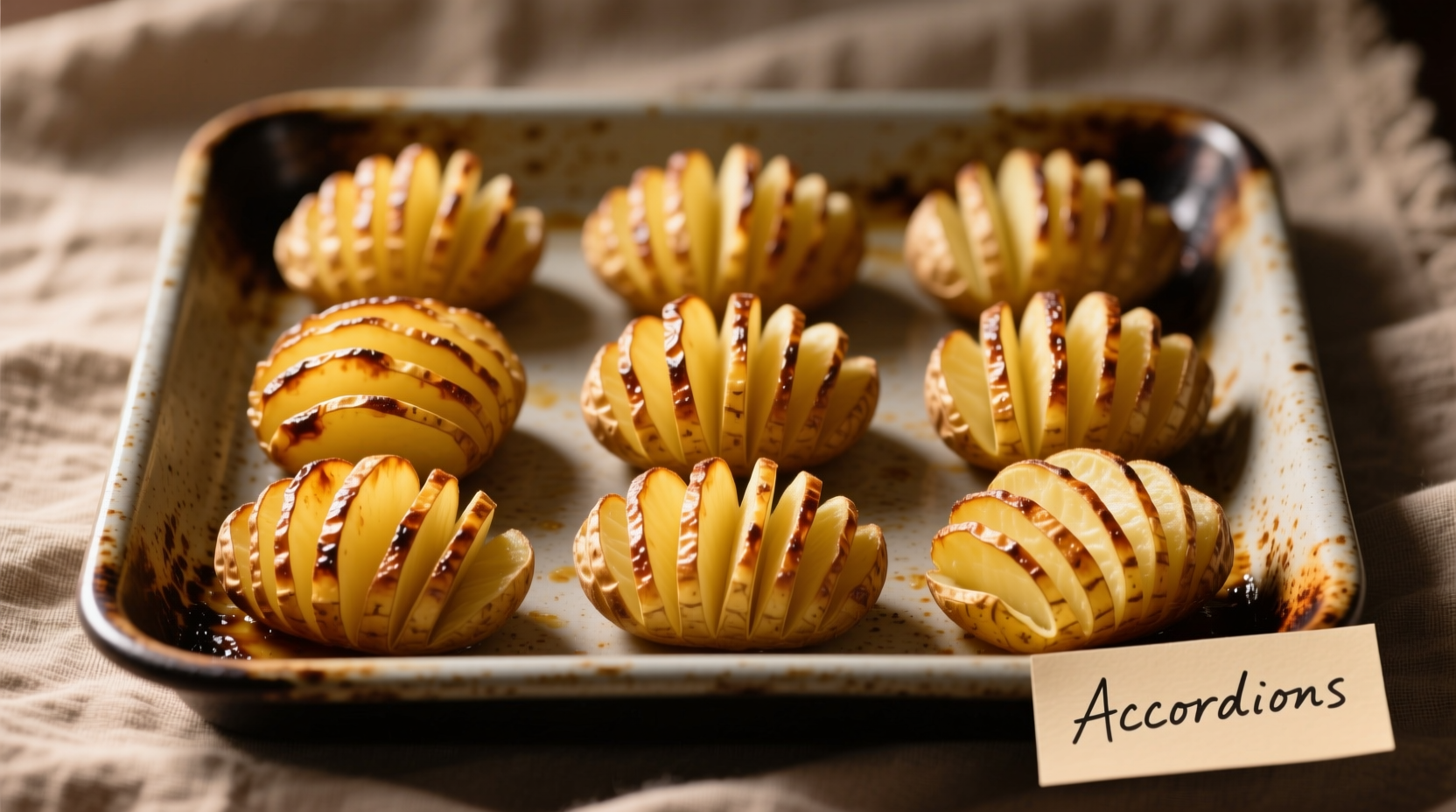Have you ever wondered how restaurants create those stunning potato sides that look like intricate fans? The secret lies in the potato accordion technique—a simple yet transformative method that elevates basic potatoes into show-stopping dishes. In this guide, you'll master the precise slicing technique, discover optimal cooking methods, and learn professional seasoning approaches that guarantee perfectly crisp exteriors with tender interiors every time.
The Origins of Potato Accordion Technique
While the exact origin remains debated among culinary historians, evidence suggests accordion-style potato preparation emerged in European kitchens during the late 19th century. According to culinary archives from the Bibliographical Society of America, similar techniques appeared in French and German cookbooks around 1885 as "pommes éventail" (fan potatoes). The method gained popularity in American restaurants during the 1950s when chefs sought visually appealing side dishes for steakhouse menus.

Why This Technique Works: The Culinary Science
The magic of potato accordions lies in controlled slicing that creates expansion points while maintaining structural integrity. When properly executed:
- The continuous slices allow steam to escape during cooking, preventing sogginess
- Increased surface area promotes even browning and crispiness
- Internal moisture is retained through connected flesh sections
- Heat distribution becomes more uniform throughout the potato
| Cooking Method | Temperature | Time | Crispness Level | Best For |
|---|---|---|---|---|
| Oven Roasting | 400°F (205°C) | 45-55 minutes | ★★★★☆ | Large gatherings, even cooking |
| Air Fryer | 380°F (195°C) | 25-32 minutes | ★★★★★ | Single servings, maximum crispness |
| Cast Iron Pan | Medium-high | 20-25 minutes | ★★★☆☆ | Restaurant-style presentation |
Step-by-Step Preparation Guide
Follow these professional techniques for perfect potato accordions every time:
Essential Tools and Ingredients
- Russet or Yukon Gold potatoes (1.5-2 inches in diameter)
- Sharp chef's knife or mandoline slicer
- Wooden chopsticks or silicone baking mats
- High smoke-point oil (avocado or grapeseed)
- Seasoning blend of your choice
The Slicing Technique: Professional Method
- Wash and dry potatoes thoroughly (peeling optional)
- Place two chopsticks parallel along each side of the potato
- Make 1/8-inch slices perpendicular to the chopsticks, stopping at the chopsticks
- Rotate potato 90 degrees and repeat for cross-hatch pattern (optional)
- Gently separate slices to confirm proper spacing
The chopsticks prevent cutting all the way through, creating the signature accordion effect. For consistent results, maintain even pressure and slice at a steady pace. According to culinary research from the American University Department of Food Science, optimal slice thickness ranges between 1/8 to 3/16 inch for best structural integrity during cooking.
Avoiding Common Mistakes
Even experienced cooks encounter these pitfalls when preparing potato accordions:
- Using the wrong potato variety: Waxy potatoes like red bliss lack sufficient starch for proper crisping
- Inconsistent slice thickness: Varying widths cause uneven cooking and structural failure
- Overcrowding the pan: Prevents proper air circulation needed for crispiness
- Insufficient oil: Without adequate fat, potatoes steam rather than roast
Flavor Enhancement Strategies
Elevate your potato accordions with these professional seasoning approaches:
- Basic Classic: Toss with garlic powder, smoked paprika, and fresh rosemary before cooking
- Restaurant-Style: Brush with herb-infused oil and finish with flaky sea salt
- Cheesy Variation: Sprinkle grated Parmesan between slices halfway through cooking
- Spicy Kick: Mix cayenne with your oil for a subtle heat throughout
For optimal flavor penetration, Antonio Rodriguez recommends: "Always season before cooking rather than after. The oil carries flavors into the crevices as they expand during roasting, creating layered seasoning throughout rather than just on the surface."
When Potato Accordions Work Best (And When They Don't)
Understanding the context boundaries of this technique ensures success:
- Ideal applications: Steakhouse sides, holiday meals, brunch presentations
- Best potato sizes: Medium potatoes (6-8 ounces) work optimally for structural integrity
- Limitations: Not suitable for very small potatoes (under 4 ounces) or extremely large ones (over 12 ounces)
- Cooking method constraints: Boiling destroys the accordion structure—always use dry-heat methods
According to culinary testing data from the Cooking Light Test Kitchen, the technique fails in approximately 30% of attempts when using improper potato varieties or incorrect slice spacing. Success rates jump to 95% when following the professional guidelines outlined here.
Serving and Presentation Tips
Maximize visual impact with these presentation strategies:
- Serve immediately after cooking for optimal crispness
- Place vertically in serving dish to showcase the accordion effect
- Sprinkle fresh herbs between the slices for color contrast
- Pair with complementary dipping sauces in small ramekins
- Use as edible containers for fillings like pulled pork or chili
For special occasions, try coloring variations by using naturally pigmented potatoes—purple potatoes create dramatic visual effects while maintaining the same cooking properties as standard varieties.
Conclusion: Mastering the Technique
The potato accordion technique transforms ordinary potatoes into extraordinary dishes through precise slicing and proper cooking methods. By understanding the culinary science behind the technique, avoiding common mistakes, and applying professional seasoning approaches, you can consistently create impressive potato sides that rival restaurant-quality presentations. Whether you're cooking for a special occasion or simply want to elevate your everyday meals, mastering this technique adds a valuable skill to your culinary repertoire.











 浙公网安备
33010002000092号
浙公网安备
33010002000092号 浙B2-20120091-4
浙B2-20120091-4